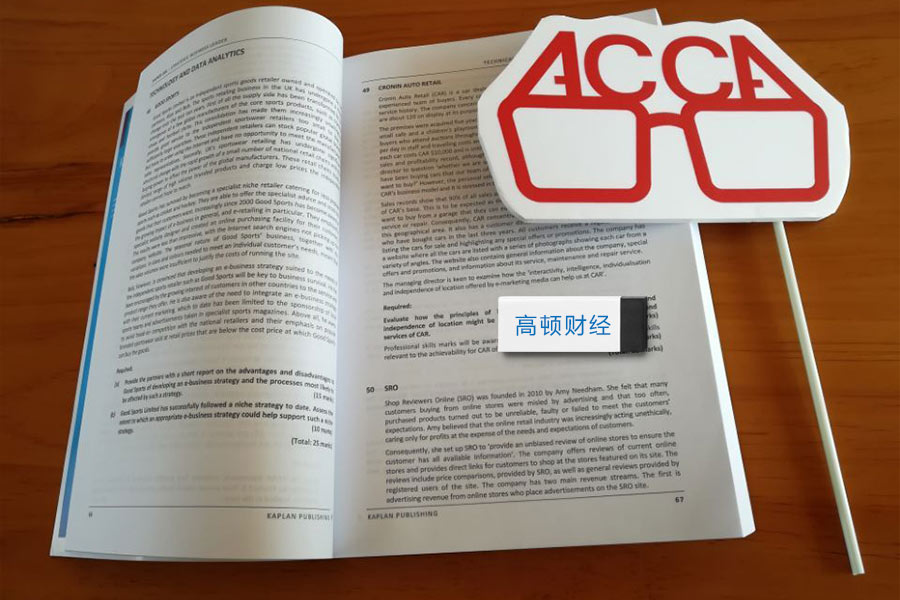2015ACCA F9财务管理考试大纲
来源:
高顿网校
2015-03-25
? ACCA 2014 All rights reserved.
1
Financial Management
(F9)
December 2014 to June
2015
This syllabus and study guide is designed to help
This syllabus and study guide is designed to help
with planning study and to provide detailed
information on what could be assessed in
any examination session.
THE STRUCTURE OF THE SYLLABUS AND
STUDY GUIDE
Relational diagram of paper with other papers
This diagram shows direct and indirect links
between this paper and other papers preceding or
following it. Some papers are directly underpinned
by other papers such as Advanced Performance
Management by Performance Management. These
links are shown as solid line arrows. Other papers
only have indirect relationships with each other
such as links existing between the accounting and
auditing papers. The links between these are shown
as dotted line arrows. This diagram indicates where
you are expected to have underpinning knowledge
and where it would be useful to review previous
learning before undertaking study.
Overall aim of the syllabus
This explains briefly the overall objective of the
paper and indicates in the broadest sense the
capabilities to be developed within the paper.
Main capabilities
This paper’s aim is broken down into several main
capabilities which divide the syllabus and study
guide into discrete sections.
Relational diagram of the main capabilities
This diagram illustrates the flows and links between
the main capabilities (sections) of the syllabus and
should be used as an aid to planning teaching and
learning in a structured way.
Syllabus rationale
This is a narrative explaining how the syllabus is
structured and how the main capabilities are linked.
The rationale also explains in further detail what the
examination intends to assess and why.
Detailed syllabus
This shows the breakdown of the main capabilities
(sections) of the syllabus into subject areas. This is
the blueprint for the detailed study guide.
Approach to examining the syllabus
This section briefly explains the structure of the
examination and how it is assessed.
Study Guide
This is the main document that students, learning
and content providers should use as the basis of
their studies, instruction and materials.
Examinations will be based on the detail of the
study guide which comprehensively identifies what
could be assessed in any examination session.
The study guide is a precise reflection and
breakdown of the syllabus. It is divided into sections
based on the main capabilities identified in the
syllabus. These sections are divided into subject
areas which relate to the sub-capabilities included
in the detailed syllabus. Subject areas are broken
down into sub-headings which describe the detailed
outcomes that could be assessed in examinations.
These outcomes are described using verbs
indicating what exams may require students to
demonstrate, and the broad intellectual level at
which these may need to be demonstrated
(*see intellectual levels below)。
INTELLECTUAL LEVELS
The syllabus is designed to progressively broaden
and deepen the knowledge, skills and professional
values demonstrated by the student on their way
through the qualification.
The specific capabilities within the detailed
syllabuses and study guides are assessed at one of
? ACCA 2014 All rights reserved.
2
three intellectual or cognitive levels:
LevelⅠ: Knowledge and comprehension
LevelⅡ: Application and analysis
LevelⅢ: Synthesis and evaluation
Very broadly, these intellectual levels relate to the
three cognitive levels at which the Knowledge
module, the Skills module and the Professional level
are assessed.
Each subject area in the detailed study guide
included in this document is given a 1, 2, or
3 superscript, denoting intellectual level, marked at
the end of each relevant line. This gives an
indication of the intellectual depth at which an area
could be assessed within the examination. However,
while level 1 broadly equates with the Knowledge
module, level 2 equates to the Skills module and
level 3 to the Professional level, some lower level
skills can continue to be assessed as the student
progresses through each module and level. This
reflects that at each stage of study there will be a
requirement to broaden, as well as deepen
capabilities. It is also possible that occasionally
some higher level capabilities may be assessed at
lower levels.
LEARNING HOURS AND EDUCATION
RECOGNITION
The ACCA qualification does not prescribe or
recommend any particular number of learning hours
for examinations because study and learning
patterns and styles vary greatly between people and
organisations. This also recognises the wide
diversity of personal, professional and educational
circumstances in which ACCA students find
themselves.
As a member of the International Federation of
Accountants, ACCA seeks to enhance the education
recognition of its qualification on both national and
international education frameworks, and with
educational authorities and partners globally. In
doing so, ACCA aims to ensure that its qualifications
are recognized and valued by governments,
regulatory authorities and employers across all
sectors. To this end, ACCA qualifications are
currently recognized on the education frameworks in
several countries. Please refer to your national
education framework regulator for further
information.
Each syllabus contains between 23 and 35 main
subject area headings depending on the nature of
the subject and how these areas have been broken
down.
GUIDE TO EXAM STRUCTURE
The structure of examinations varies within and
between modules and levels.
The Fundamentals level examinations contain
100% compulsory questions to encourage
candidates to study across the breadth of each
syllabus.
The Knowledge module is assessed by equivalent
two-hour paper based and computer based
examinations.
The Skills module examinations F5-F9 are all paper
based three-hour papers containing a mix of
objective and longer type questions. The Corporate
and Business Law (F4) paper is a two- hour
computer based objective test examination which is
also available as a paper based version from the
December 2014 examination session.
The Professional level papers are all three-hour
paper based examinations, all containing two
sections. Section A is compulsory, but there will be
some choice offered in Section B.
For all three hour examination papers, ACCA has
introduced 15 minutes reading and planning time.
This additional time is allowed at the beginning of
each three-hour examination to allow candidates to
read the questions and to begin planning their
answers before they start writing in their answer
books. This time should be used to ensure that all
the information and exam requirements are properly
read and understood.
During reading and planning time candidates may
only annotate their question paper. They may not
write anything in their answer booklets until told to
do so by the invigilator.
The Essentials module papers all have a Section A
containing a major case study question with all
requirements totalling 50 marks relating to this
case. Section B gives students a choice of two from
? ACCA 2014 All rights reserved.
3
three 25 mark questions.
Section A of both the P4 and P5 Options papers
contain one 50 mark compulsory question, and
Section B will offer a choice of two from three
questions each worth 25 marks each.
Section A of each of the P6 and P7 Options papers
contains 60 compulsory marks from two questions;
question 1 attracting 35 marks, and question 2
attracting 25 marks. Section B of both these
Options papers will offer a choice of two from three
questions, with each question attracting 20 marks.
All Professional level exams contain four
professional marks.
The pass mark for all ACCA Qualification
examination papers is 50%.
GUIDE TO EXAMINATION ASSESSMENT
ACCA reserves the right to examine anything
contained within the study guide at any examination
session. This includes knowledge, techniques,
principles, theories, and concepts as specified.
For the financial accounting, audit and assurance,
law and tax papers except where indicated
otherwise, ACCA will publish examinable
documents once a year to indicate exactly
what regulations and legislation could potentially be
assessed within identified examination sessions
For paper based examinations regulation issued or
legislation passed on or before 31st August annually,
will be examinable from 1st September of the
following year to 31st August t of the year after that.
Please refer to the examinable documents for the
paper (where relevant) for further information.
Regulation issued or legislation passed in
accordance with the above dates may be
examinable even if the effective date is in the future.
The term issued or passed relates to when
regulation or legislation has been formally approved.
The term effective relates to when regulation or
legislation must be applied to an entity transactions
and business practices.
The study guide offers more detailed guidance on
the depth and level at which the examinable
documents will be examined. The study guide
should therefore be read in conjunction with the
examinable documents list.
? ACCA 2014 All rights reserved.
4
Syllabus
AIM
To develop the knowledge and skills expected of a
finance manager, in relation to investment,
financing, and dividend policy decisions.
MAIN CAPABILITIES
On successful completion of this paper candidates
should be able to:
A Discuss the role and purpose of the financial
management function
B Assess and discuss the impact of the
economic environment on financial
management
C Discuss and apply working capital
management techniques
D Carry out effective investment appraisal
E Identify and evaluate alternative sources of
business finance
F Discuss and apply principles of business
and asset valuations
G Explain and apply risk management
techniques in business.
RELATIONAL DIAGRAM OF MAIN CAPABILITIES
FM (F9)
AFM (P4)
MA (F2)
Business
finance (E)
Investment appraisal
(D)
Business valuations (F)
Risk management (G)
Financial management environment (B)
Financial
management function
(A)
Working capital
management (C)
? ACCA 2014 All rights reserved.
5
RATIONALE
The syllabus for Paper F9, Financial Management,
is designed to equip candidates with the skills that
would be expected from a finance manager
responsible for the finance function of a business. It
prepares candidates for more advanced and
specialist study in Paper P4, Advanced Financial
Management
The paper, therefore, starts by introducing the role
and purpose of the financial management function
within a business. Before looking at the three key
financial management decisions of investing,
financing, and dividend policy, the syllabus explores
the economic environment in which such decisions
are made.
The next section of the syllabus is the introduction
of investing decisions. This is done in two stages -
investment in (and the management of) working
capital and the appraisal of long-term investments.
The next area introduced is financing decisions. This
section of the syllabus starts by examining the
various sources of business finance, including
dividend policy and how much finance can be
raised from within the business. It also looks at the
cost of capital and other factors that influence the
choice of the type of capital a business will raise.
The principles underlying the valuation of business
and financial assets, including the impact of cost of
capital on the value of business, is covered next.
The syllabus finishes with an introduction to, and
examination of, risk and the main techniques
employed in the management of such risk.
? ACCA 2014 All rights reserved.
6
DETAILED SYLLABUS
A Financial management function
1. The nature and purpose of financial
management
2. Financial objectives and relationship with
corporate strategy
3. Stakeholders and impact on corporate
objectives
4. Financial and other objectives in not-for-profit
organisations
B Financial management environment
1. The economic environment for business
2. The nature and role of financial markets and
institutions
3. The nature and role of money market
C Working capital management
1. The nature, elements and importance of
working capital
2. Management of inventories, accounts
receivable, accounts payable and cash
3. Determining working capital needs and funding
strategies
D Investment appraisal
1. Investment appraisal techniques
2. Allowing for inflation and taxation in
investment appraisal
3. Adjusting for risk and uncertainty in investment
appraisal
4. Specific investment decisions (lease or buy;
asset replacement, capital rationing)
E Business finance
1. Sources of, and raising business finances
2. Estimating the cost of capital
3. Sources of finance and their relative costs
4. Capital structure theories and practical
considerations
5. Finance for small and medium sized entities
F Business valuations
1. Nature and purpose of the valuation of
business and financial assets
2. Models for the valuation of shares
3. The valuation of debt and other financial assets
4. Efficient market hypothesis (EMH) and
practical considerations in the valuation of
shares
G Risk management
1. The nature and types of risk and approaches to
risk management
2. Causes of exchange rate differences and
interest rate fluctuations
3. Hedging techniques for foreign currency risk
4. Hedging techniques for interest rate risk
? ACCA 2014 All rights reserved.
7
APPROACH TO EXAMINING THE SYLLABUS
The syllabus is assessed by a three-hour paperbased
examination.
All questions are compulsory. It will contain both
computational and discursive elements.
Some questions will adopt a scenario/case study
approach.
Section A of the exam comprises 20 multiple choice
questions of 2 marks each.
Section B of the exam comprises three 10 mark
questions and two 15 mark questions.
The two 15 mark questions will come from working
capital management, investment appraisal and
business finance areas of the syllabus. The section
A questions and the other questions in section B
can cover any areas of the syllabus.
Candidates are provided with a formulae sheet and
tables of discount and annuity factors
? ACCA 2014 All rights reserved.
8
Study Guide
A FINANCIAL MANAGEMENT FUNCTION
1. The nature and purpose of financial
management
a) Explain the nature and purpose of financial
management.[1]
b) Explain the relationship between financial
management and financial and management
accounting.[1]
2. Financial objectives and the relationship with
corporate strategy
a) Discuss the relationship between financial
objectives, corporate objectives and corporate
strategy.[2]
b) Identify and describe a variety of financial
objectives, including: [2]
i) shareholder wealth maximisation
ii) profit maximisation
iii) earnings per share growth
3. Stakeholders and impact on corporate
objectives
a) Identify the range of stakeholders and their
objectives [2]
b) Discuss the possible conflict between
stakeholder objectives [2]
c) Discuss the role of management in meeting
stakeholder objectives, including the
application of agency theory.[2]
d) Describe and apply ways of measuring
achievement of corporate objectives
including: [2]
i) ratio analysis, using appropriate ratios such
as return on capital employed, return on
equity, earnings per share and dividend per
share
ii) changes in dividends and share prices as
part of total shareholder return
e) Explain ways to encourage the achievement of
stakeholder objectives, including: [2]
i) managerial reward schemes such as share
options and performance-related pay
ii) regulatory requirements such as corporate
governance codes of best practice and stock
exchange listing regulations
4. Financial and other objectives in not-for-profit
organisations
a) Discuss the impact of not-for-profit status on
financial and other objectives.[2]
b) Discuss the nature and importance of Value for
Money as an objective in not-for-profit
organisations.[2]
c) Discuss ways of measuring the achievement of
objectives in not-for-profit organisations.[2]
B FINANCIAL MANAGEMENT ENVIRONMENT
1. The economic environment for business
a) Identify and explain the main macroeconomic
policy targets.[1]
b) Define and discuss the role of fiscal, monetary,
interest rate and exchange rate policies in
achieving macroeconomic policy targets.[1]
c) Explain how government economic policy
interacts with planning and decision-making in
business.[2]
d) Explain the need for, and the interaction with,
planning and decision-making in business of: [1]
i) competition policy
ii) government assistance for business
iii) green policies
iv) corporate governance regulation.[2]
2. The nature and role of financial markets and
institutions
a) Identify the nature and role of money and
capital markets, both nationally and
internationally.[2]
b) Explain the role of financial intermediaries.[1]
c) Explain the functions of a stock market and a
corporate bond market.[2]
? ACCA 2014 All rights reserved.
9
d) Explain the nature and features of different
securities in relation to the risk/return tradeoff.[
2]
3. The nature and role of money market
a) Describe the role of the money markets in:[1]
i) Providing short-term liquidity to industry
and the public sector
ii) Providing short-term trade finance
iii) Allowing an organisation to manage its
exposure to foreign currency risk and
interest rate risk.
b) Explain the role of banks and other financial
institutions in the operation of the money
markets.[2]
c) Explain the characteristics and role of the
principal money market instruments:[2]
i) Interest-bearing instruments
ii) Discount instruments
iii) Derivative products.
C WORKING CAPITAL MANAGEMENT
1. The nature, elements and importance of
working capital
a) Describe the nature of working capital and
identify its elements.[1]
b) Identify the objectives of working capital
management in terms of liquidity and
profitability, and discuss the conflict between
them.[2]
c) Discuss the central role of working capital
management in financial management.[2]
2. Management of inventories, accounts
receivable, accounts payable and cash
a) Explain the cash operating cycle and the role of
accounts payable and accounts receivable.[2]
b) Explain and apply relevant accounting ratios,
including: [2]
i) current ratio and quick ratio
ii) inventory turnover ratio, average collection
period and average payable period
iii) sales revenue/net working capital ratio
c) Discuss, apply and evaluate the use of relevant
techniques in managing inventory, including
the Economic Order Quantity model and Justin-
Time techniques.[2]
d) Discuss, apply and evaluate the use of relevant
techniques in managing accounts receivable,
including:
i) assessing creditworthiness [1]
ii) managing accounts receivable [1]
iii) collecting amounts owing [1]
iv) offering early settlement discounts [2]
v) using factoring and invoice discounting [2]
vi) managing foreign accounts receivable [2]
e) Discuss and apply the use of relevant
techniques in managing accounts payable,
including:
i) using trade credit effectively [1]
ii) evaluating the benefits of discounts for early
settlement and bulk purchase [2]
iii) managing foreign accounts payable [1]
f) Explain the various reasons for holding cash,
and discuss and apply the use of relevant
techniques in managing cash, including:[2]
i) preparing cash flow forecasts to determine
future cash flows and cash balances
ii) assessing the benefits of centralised
treasury management and cash control
iii) cash management models, such as the
Baumol model and the Miller-Orr model
iv) investing short-term
3. Determining working capital needs and funding
strategies
a) Calculate the level of working capital
investment in current assets and discuss the
key factors determining this level, including:[2]
i) the length of the working capital cycle and
terms of trade
ii) an organisation’s policy on the level of
investment in current assets
iii) the industry in which the organisation
operates
b) Describe and discuss the key factors in
determining working capital funding strategies,
including:[2]
i) the distinction between permanent and
fluctuating current assets
? ACCA 2014 All rights reserved.
10
ii) the relative cost and risk of short-term and
long-term finance
iii) the matching principle
iv) the relative costs and benefits of
aggressive, conservative and matching
funding policies
v) management attitudes to risk, previous
funding decisions and organisation size [1]
D INVESTMENT APPRAISAL
1. Investment appraisal techniques
a) Identify and calculate relevant cash flows for
investment projects.[2]
b) Calculate payback period and discuss the
usefulness of payback as an investment
appraisal method.[2]
c) Calculate discounted payback and discuss its
usefulness as an investment appraisal
method.[2]
d) Calculate return on capital employed
(accounting rate of return) and discuss its
usefulness as an investment appraisal
method.[2]
e) Calculate net present value and discuss its
usefulness as an investment appraisal
method.[2]
f) Calculate internal rate of return and discuss its
usefulness as an investment appraisal
method.[2]
g) Discuss the superiority of discounted cash flow
(DCF) methods over non-DCF methods.[2]
h) Discuss the relative merits of NPV and IRR.[2]
2. Allowing for inflation and taxation in DCF
a) Apply and discuss the real-terms and nominalterms
approaches to investment appraisal.[2]
b) Calculate the taxation effects of relevant cash
flows, including the tax benefits of capital
allowances and the tax liabilities of taxable
profit.[2]
c) Calculate and apply before- and after-tax
discount rates.[2]
3. Adjusting for risk and uncertainty in investment
appraisal
a) Describe and discuss the difference between
risk and uncertainty in relation to probabilities
and increasing project life.[2]
b) Apply sensitivity analysis to investment projects
and discuss the usefulness of sensitivity
analysis in assisting investment decisions.[2]
c) Apply probability analysis to investment
projects and discuss the usefulness of
probability analysis in assisting investment
decisions.[2]
d) Apply and discuss other techniques of
adjusting for risk and uncertainty in investment
appraisal, including:
i) simulation [1]
ii) adjusted payback [1]
iii) risk-adjusted discount rates [2]
4. Specific investment decisions (Lease or buy;
asset replacement; capital rationing)
a) Evaluate leasing and borrowing to buy using
the before-and after-tax costs of debt.[2]
b) Evaluate asset replacement decisions using
equivalent annual cost.[2]
c) Evaluate investment decisions under singleperiod
capital rationing, including:[2]
i) the calculation of profitability indexes for
divisible investment projects
ii) the calculation of the NPV of combinations
of non-divisible investment projects
iii) a discussion of the reasons for capital
rationing
E BUSINESS FINANCE
1. Sources of and raising business finance
a) Identify and discuss the range of short-term
sources of finance available to businesses,
including: [2]
i) overdraft
ii) short-term loan
? ACCA 2014 All rights reserved.
11
iii) trade credit
iv) lease finance
b) Identify and discuss the range of long-term
sources of finance available to businesses,
including: [2]
i) equity finance
ii) debt finance
iii) lease finance
iv) venture capital
c) Identify and discuss methods of raising equity
finance, including: [2]
i) rights issue
ii) placing
iii) public offer
iv) stock exchange listing
d) Identify and discuss methods of raising short
and long term Islamic finance including[1]
i) major difference between Islamic finance
and the other forms of business finance.
ii) The concept of riba (interest) and
how returns are made by Islamic financial
securities.
iii) Islamic financial instruments
available to businesses including
i) murabaha (trade credit)
ii) Ijara (lease finance)
iii) mudaraba (equity finance)
iv) sukuk (debt finance)
v) musharaka (venture capital)
(note: calculations are not required)
e) Identify and discuss internal sources of finance,
including:[2]
i) retained earnings
ii) increasing working capital management
efficiency
iii) the relationship between dividend policy
and the financing decision
iv) the theoretical approaches to, and the
practical influences on, the dividend
decision, including legal constraints,
liquidity, shareholding expectations and
alternatives to cash dividends
2. Estimating the cost of capital
a) Estimate the cost of equity including.[2]
i) Application of the dividend growth model
and discussion of its weaknesses.
ii) Explaination and discussion of systematic
and unsystematic risk.
iii) Relationship between portfolio theory and
the capital asset pricing model (CAPM)
iv) Application of the CAPM, its assumptions,
advantages and disadvantages its
b) Estimating the cost of debt
i) irredeemable debt
ii) redeemable debt
iii) convertible debt
iv) preference shares
v) bank debt
c) Estimating the overall cost of capital
including.[2]:
i) Distinguishing between average and
marginal cost of capital
ii) Calculating the weighted average cost of
capital (WACC) using book value and
market value weightings
3. Sources of finance and their relative costs
a) Describe the relative risk-return relationship
and the relative costs of equity and debt.[2]
b) Describe the creditor hierarchy and its
connection with the relative costs of sources of
finance.[2]
c) Identify and discuss the problem of high levels
of gearing [2]
d) Assess the impact of sources of finance on
financial position, financial risk and
shareholder wealth using appropriate
measures, including[2]:
i) ratio analysis using statement of financial
position gearing, operational and financial
gearing, interest coverage ratio and other
relevant ratios
ii) cash flow forecasting
iii) leasing or borrowing to buy
e) Impact of cost of capital on investments
including.[2]
i) the relationship between company value
and cost of capital.
ii) the circumstances under which WACC can
be used in investment appraisal
iii) the advantages of the CAPM over WACC in
determining a project-specific cost of capital
? ACCA 2014 All rights reserved.
12
the advantages of the CAPM over WACC in
determining a project-specific cost of capital
iv) Application of CAPM in calculating a
project-specific discount rate.
4. Capital structure theories and practical
considerations
a) Describe the traditional view of capital
structure and its assumptions.[2]
b) Describe the views of Miller and Modigliani on
capital structure, both without and with
corporate taxation, and their assumptions.[2]
c) Identify a range of capital market imperfections
and describe their impact on the views of
Miller and Modigliani on capital structure.[2]
d) Explain the relevance of pecking order theory to
the selection of sources of finance.[1]
5. Finance for small and medium sized entities
(SMEs)
a) Describe the financing needs of small
businesses.[2]
b) Describe the nature of the financing problem
for small businesses in terms of the funding
gap, the maturity gap and inadequate
security.[2]
c) Explain measures that may be taken to ease
the financing problems of SMEs, including the
responses of government departments and
financial institutions.[1]
d) Identify appropriate sources of finance for
SMEs and evaluate the financial impact of
different sources of finance on SMEs.[2]
F BUSINESS VALUATIONS
1. Nature and purpose of the valuation of
business and financial assets
a) Identify and discuss reasons for valuing
businesses and financial assets.[2]
b) Identify information requirements for valuation
and discuss the limitations of different types of
information.[2]
2. Models for the valuation of shares
a) Asset-based valuation models, including:[2]
i) net book value (statement of financial
position basis)。
ii) net realisable value basis.
iii) net replacement cost basis.
b) Income-based valuation models, including:[2]
i) price/earnings ratio method.
ii) earnings yield method.
c) Cash flow-based valuation models, including:[2]
i) dividend valuation model and the dividend
growth model.
ii) discounted cash flow basis.
3. The valuation of debt and other financial assets
a) Apply appropriate valuation methods to:[2]
i) irredeemable debt
ii) redeemable debt
iii) convertible debt
iv) preference shares
4. Efficient Market Hypothesis (EMH) and
practical considerations in the valuation of
shares
a) Distinguish between and discuss weak form
efficiency, semi-strong form efficiency and
strong form efficiency [2]
b) Discuss practical considerations in the
valuation of shares and businesses,
including:[2]
i) marketability and liquidity of shares
ii) availability and sources of information
iii) market imperfections and pricing
anomalies
iv) market capitalisation
c) Describe the significance of investor
speculation and the explanations of investor
decisions offered by behavioural finance [1]
? ACCA 2014 All rights reserved.
13
G RISK MANAGEMENT
1. The nature and types of risk and approaches to
risk management
a) Describe and discuss different types of foreign
currency risk:[2]
i) translation risk
ii) transaction risk
iii) economic risk
b) Describe and discuss different types of interest
rate risk:[1]
i) gap exposure
ii) basis risk
2. Causes of exchange rate differences and
interest rate fluctuations
a) Describe the causes of exchange rate
fluctuations, including:
i) balance of payments [1]
ii) purchasing power parity theory [2]
iii) interest rate parity theory [2]
iv) four-way equivalence [2]
b) Forecast exchange rates using:[2]
i) purchasing power parity
ii) interest rate parity
c) Describe the causes of interest rate
fluctuations, including: [2]
i) structure of interest rates and yield curves
ii) expectations theory
iii) liquidity preference theory
iv) market segmentation
3. Hedging techniques for foreign currency risk
a) Discuss and apply traditional and basic
methods of foreign currency risk management,
including:
i) currency of invoice [1]
ii) netting and matching [2]
iii) leading and lagging [2]
iv) forward exchange contracts [2]
v) money market hedging [2]
vi) asset and liability management [1]
b) Compare and evaluate traditional methods of
foreign currency risk management.[2]
c) Identify the main types of foreign currency
derivates used to hedge foreign currency risk
and explain how they are used in hedging.[1]
(No numerical questions will be set on this
topic)
4. Hedging techniques for interest rate risk
a) Discuss and apply traditional and basic
methods of interest rate risk management,
including:
i) matching and smoothing [1]
ii) asset and liability management [1]
ii) forward rate agreements [2]
b) Identify the main types of interest rate
derivates used to hedge interest rate risk and
explain how they are used in hedging.[1]
(No numerical questions will be set on this
topic)
? ACCA 2014 All rights reserved.
14
SUMMARY OF CHANGES TO F9
ACCA periodically reviews its qualification
syllabuses so that they fully meet the needs of
stakeholders such as employers, students,
regulatory and advisory bodies and learning
providers.
There are no changes to the syllabus except rearrangement of syllabus sections. Section on cost of capital is now
part of business finance section.
高顿网校温馨提示: 通过ACCA考试实属不易,首先要有执着的精神,其次是不断勤奋的学习,高顿网校为大家提供ACCA题库免费做题,希望助大家一臂之力,查看详情》
| ACCA网络课程 | 课程专业名称 | 讲师 | 试听 |
 85%的人正在学习该课程 85%的人正在学习该课程 | ACCA 全维度网课体验课程 实景课堂与独立录制 覆盖所有知识点,根据学习计划推进学习进度 | 高顿名师 |  |
 70%的人正在学习该课程 70%的人正在学习该课程 | ACCA网课全科卡(8.2折) 为零基础刚开始学习ACCA的学员特别定制 | 高顿名师 |  |
精彩推荐:
版权声明:本条内容自发布之日起,有效期为一个月。凡本网站注明“来源高顿教育”或“来源高顿网校”或“来源高顿”的所有作品,均为本网站合法拥有版权的作品,未经本网站授权,任何媒体、网站、个人不得转载、链接、转帖或以其他方式使用。
经本网站合法授权的,应在授权范围内使用,且使用时必须注明“来源高顿教育”或“来源高顿网校”或“来源高顿”,并不得对作品中出现的“高顿”字样进行删减、替换等。违反上述声明者,本网站将依法追究其法律责任。
本网站的部分资料转载自互联网,均尽力标明作者和出处。本网站转载的目的在于传递更多信息,并不意味着赞同其观点或证实其描述,本网站不对其真实性负责。
如您认为本网站刊载作品涉及版权等问题,请与本网站联系(邮箱fawu@gaodun.com,电话:021-31587497),本网站核实确认后会尽快予以处理。
点一下领资料
【整理版】ACCA各科目历年真题
真题高频考点,刷题全靠这份资料
下载合集
acca全科学习思维导图
梳理核心考点,一图看懂全部章节
下载合集
2023年acca考纲解析
覆盖科目重难点,备考按照计划走
下载合集
acca备考 热门问题解答
- acca考试怎么搭配科目?
-
建议优先选择相关联的科目进行搭配报考,这样可以提高备考效率,减轻备考压力,1、F1-F4:为随时机考科目,难度较低,这里可以自行随意选择考试顺序。2、F5-F9:如果你的工作的和财务会计或者审计有关、或者你比较擅长财务和审计的话,推荐先考F7和F8。你可以选择一起考ACCA考试科目F7和F8或者先考F7(8)再考F8(7),这就要取决你一次想考几门。3、P阶段:选修科目中,建议企业首选AFM!第二部分科目进行选择,如果AA和SBR掌握学生更好,可以通过选择AAA,如果SBL掌握的好,可以自己选择APM。
- acca一共几门几年考完?
-
acca一共有15门考试科目,其中有必修科目和选修科目,考生需要考完13门科目才能拿下证书。
- acca一年考几次?
-
acca一年有4次考试,分别是3月、6月、9月和12月,分季机考科目是采取的这类四个考季的模式,而随时机考则是没有这方面的时间规定限制,可以随报随考。
- acca的含金量如何?
-
ACCA证书的含金量是比较高的,从就业、能力提升、全球认可等角度来说,都是比较有优势的证书,其含金量主要表现在以下几个方面:1、国际化,认可度高;2、岗位多,就业前景好;3、缺口大,人才激励。
严选名师 全流程服务
其他人还搜了
热门推荐
-
长春ACCA培训课程,高顿ACCA推荐吗? 2023-06-19
-
【考试重点】acca2023年9月SBL变化详解,速进了解! 2023-06-19
-
acca《PM业绩管理》考试大纲变化,2023年9月起变动情况一览! 2023-04-26
-
2023年6月acca考试哪些科目考纲有变化?赶快来看! 2023-04-25
-
ACCA2023年考试重点介绍,新手看过来! 2023-03-29
-
9月acca考试考纲变了吗?这些科目变动你要了解! 2023-03-10
-
acca考纲每次变化大吗?2023年9月起变动0%-12%! 2023-03-10
-
ACCA科目名称英文一览 2022-05-23
-
ACCA都考什么内容? 2022-05-20
-
ACCA课程内容介绍 2022-05-12
-
2022年ACCA考试一共要考几科? 2022-05-11
-
ACCA的考试内容都有什么? 2022-05-10
-
ACCA官网操作 | 如何鉴别自己是FIA还是ACCA&考试报名退考流程 2021-06-30
-
2020年最新ACCA考试大纲哪里找? 2020-03-04
-
2014年12月ACCA考试改动方向及难度变化,资阳考生必看! 2019-01-04
-
2014年12月ACCA考试改动方向及难度变化,资阳考生必看! 2019-01-04
-
2018年ACCA考试新旧考纲变化详解 2019-01-02
-
12月ACCA考试前瞻:2017年9月ACCA F7考试分析 2017-11-21
-
ACCA考试F8考试大纲变化解析 2017-04-19
-
ACCA考试F7考纲变化分析 2017-01-04
-
acca福建厦门考点i831在哪里 2016-12-19
-
拉萨有没有比较好的ACCA培训机构? 2016-06-29
-
石嘴山有没有比较好的ACCA培训机构? 2016-06-29
-
嘉峪关有没有比较好的ACCA培训机构? 2016-06-29
-
吐鲁番有没有比较好的ACCA培训机构? 2016-06-29
-
武夷山有没有比较好的ACCA培训机构? 2016-06-29
-
保山有没有比较好的ACCA培训机构? 2016-06-22
-
果洛有没有比较好的ACCA培训机构? 2016-06-22
-
临夏有没有比较好的ACCA培训机构? 2016-06-22
-
喀什有没有比较好的ACCA培训机构? 2016-06-22
 更多服务
更多服务





























